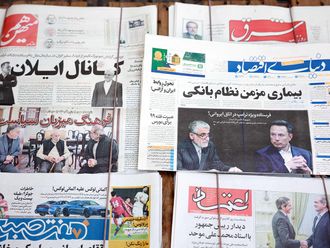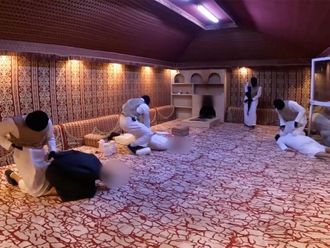Cairo: Festive lanterns, shaped like the famous cartoon character SpongeBob, are all the rage in Egypt as the predominantly Muslim country spruces up to celebrate Ramadan.
“Chinese suppliers have flooded the market with the attractive Spongebob lanterns weeks ahead of Ramadan,” said Metwali Farouk, a trader in lanterns, which are an age-old feature of the month of Ramadan in Egypt.
“Variations of these lanterns have become immensely popular with children due to their colourful shapes and dancing tunes,” Farouk told Gulf News.
According to him, prices of the battery-operated SpongeBob lanterns range from 25 to 35 Egyptian pounds (Dh15 to Dh21) pounds, depending on their features.
“The SpongeBob variations includes lanterns that emit lights while playing local Ramadan songs. Others, in addition to these features, produce bubbles when they are switched on,” explained Farouk, who sells the seasonal goods in the central Cairo bazaar area of Al Muski.
Farouk retails other lanterns modelled on the Asian three-wheelers known in Egypt as tok-toks, and armoured vehicles, apparently inspired by the army’s rule of the country in the wake of a popular revolt that toppled long-standing president Hosni Mubarak more than a year ago.
“The revolutionary fervour has eased after the presidential election (held in May and June). Now people want stability and a better life,” said Farouk. “These wishes have been reflected on this year’s lantern market, making Spongebob the No.1 lantern,” he added.
Despite the massive popularity of the Chinese-made lanterns, local merchants insist that the traditional metal lanterns, locally called fawanees, have not lost their allure.
“Children like the Chinese lanterns because of their attractive and various models. However, the traditional tin lantern continues to attract the older Egyptians, as it reminds them of their childhood years when this kind of lantern was popular,” said Mustafa Serag, a trader in Al Muski.
“Moreover, the traditional lanterns with their stained glass are in high demand from hotels and Ramadan-themed tents because these lanterns capture the Egyptian spirit of Ramadan,” he told this newspaper. “Some foreign tourists are keen to buy these lanterns as souvenirs,” he added.
Hotels and fashionable cafes use large metal lanterns as decorations during Ramadan when Muslims have to abstain from eating, drinking and sex from dawn to sunset.
“Large metal lanterns sell for 100 to 300 [Egyptian] pounds, depending on their size and shape,” said Serag, who has been in the trade for more than 30 years.
“The Chinese manufacturers are clever. Every year, they come to Egypt to study the market needs and come up with innovative shapes that attract mainly children,” said Serag, 55. “It is unfair for Egypt to lose in the manufacture of lanterns in which it excelled for many years.”
According to some historians, the first candle-lit lanterns were used in Egypt on the seventh day of Ramadan in 362 AH (Islamic calendar) on June 11, 972 AD, when residents of Cairo took to streets in the evening to welcome the arrival of their new Fatimid ruler Al Moez Lidin–Allah. Some people in the large crowd were carrying lanterns while happily singing.
From then on, candle-lit lanterns became an indispensable tradition of the lunar month of Ramadan, the historians say.
The lantern-making industry thrived under the Fatimids, who ruled Egypt for nearly two centuries.












